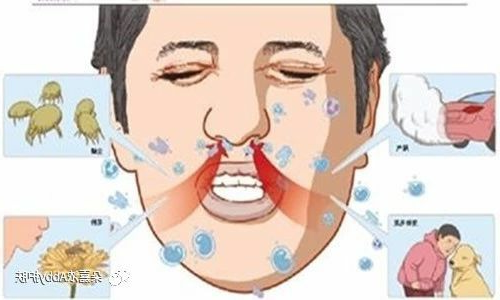Email: enquiries@huiallergy.com
Zip Code: 121000
电话:13904063938
Address: Jinzhou City, Liaoning Province
No. 46-1 Huanghai Street, Songshan New District
What are allergens?What are the allergens?
Antigens enter atopic patients through various ways, and after contact with immunoactive cells, the sensitization process begins。The antigenic substances that sensitize humans are called allergens, also known as allergens。
There are many types of allergens and they can come from different sources。In theory, all substances in the environment are potential allergens。Clinically, according to the route of entry into the body, allergens can be divided into the following categories:
Inhaled allergens: inhaled allergens mostly come from the living environment and sensitize the body in the respiratory tract, and the target organs are mostly respiratory organs, but they can also be organs outside the respiratory system。Depending on the source, inhalation allergens are of the following types:
pollen。Pollen is the male germ cell of higher plants。Anemophilous flowers are the main causes of allergy. Their pollen is large, small and light, and can be dispersed by wind for hundreds of miles.Media flowers, ornamental flowers cause less allergy。Pollen dispersal is strictly seasonal and is easily affected by climate (such as rain and wind), and can be roughly divided into three categories according to different pollen dispersal times。First, tree pollen: pollinated in spring, such as poplar, birch, elm, willow, ash, Chinese fir, Ailanthus, maple poplar, Sycamilla and so on。The second is grass pollen: mostly grasses, such as corn, wheat, sorghum, sunflower, castor and so on, mostly pollinated in summer。The third is weed pollen: pollinated in autumn, the main weed in North America is ragweed, which is divided into several species。Artemisia pollens are the most important in north China, among which Artemisia macrophylla (also known as Artemisia white) and Artemisia flavescens are the most common。Rufen is another major allergenic pollen。In addition, hemp, Xanthium, cattail, and Xanthium are also important allergens。
fungi。Fungi are a group of lower plants without roots, stems and leaves, belonging to the phylum fungi。It does not contain chlorophyll, so it cannot use inorganic substances for photosynthesis, but only parasitic or saprophytic life。Most fungi have mycelium and can reproduce sexually or asexually。Fungi are easy to grow in a wet and warm environment, so its distribution also has regional differences, more in coastal areas or inland humid areas, but in general, except for the polar regions, fungi spread all over the world。In different seasons, the distribution of fungi is not the same, generally more in summer and autumn, winter
Post-snow light。However, because the fungus can easily move indoors and reproduce there, it can become a perennial allergen, and the density of the fungus in the air may be higher in winter than in summer when the air is not circulated, the indoor humidity is high, and the heating is excessive。
Fungal sensitization is usually manifested as plum knot or perennial rhinitis and asthma。Unlike hay fever, it causes conjunctivitis less often, and when it does, the symptoms are milder。Fungal sensitization in adults is partly related to occupation, and often occurs in jobs with more fungi in the working environment, such as brewing industry, pharmaceutical industry, agriculture, textile industry, leather industry, warehouse, library, animal house, greenhouse, etc。Fungal allergy is often caused by inhalation of fungal antigens, but sometimes by ingestion or contact。The specific test technique can prove the presence of specific fungal antibodies in the patient。
③ Other phytogenic inhalation allergens
● Kapok: Kapok is mainly produced in Indonesia。Its fiber is widely used in the production of mattresses, sofa cushions, pillow cushions, sleeping bags, life jackets and so on。Long-term exposure to kapok can cause respiratory allergy。
Pyrethrum: Pyrethrum is a member of the Compositae family and is therefore botanically related to ragweed and Artemisia, which often cause hay fever。Flower use of pyrethrum!To manufacture insecticides, is also the raw material of mosquito coil incense;Its dust, smoke, spray, etc., can induce respiratory symptoms。Asthma patients can often be caused by inhaling mosquito incense smoke asthma attack, this stimulation can be specific or non-specific。
● Castor bean: The allergenic components of castor bean are mainly found in castor bean seeds and pollen。Castor residue, which has been pressed for oil, is used as an organic fertilizer and is highly allergenic。Sensitization can occur by direct contact with or inhalation of dust discharged from castor processing plants。
Beans: In addition to being a food, soybeans have a wide range of industrial uses。As an industrial raw material, soybean dust can sensitize the human body through inhalation, which is easy to occur in the food processing industry, fertilizer, feed, glue, tape, waterproof agent, artificial wool and other industries。
● Cotton seed: The sensitizing component of cotton seed is a water-soluble protein substance。The allergic reaction caused by cottonseed is mostly caused by inhaling cottonseed dust, which exists in pillow, mattress, cottonseed fertilizer or feed.It is also occasionally caused by ingestion of cotton seed food。However, cottonseed oil rarely causes allergic reactions, although it has a wide range of industrial uses, this is because it contains less protein components, and in the processing process including 400 ° C above the distillation process, after such treatment, the only antigenicity has been destroyed。
● Flaxseed: linseed is also widely used in industry。Flaxseed also contains strong sensitizing substances。Sensitization can be caused by inhalation or contact with linseed containing feed, shampoo, hair removal agents, linoleum, insulation or by taking cough and laxatives containing linseed, and by drinking milk from animals raised on linseed feed。
Vegetable glue: Vegetable glue is often used as food additives, drug excipients, emulsifiers, adhesives, proofing agents, etc。It is also widely used in industries such as printing, makeup, paper making and medicine。The vegetable gum with strong sensitization is Arabic gum, wutong gum, Xihuang elite gum and so on。
● Actinomycetes: Thermophilic actinomycetes that can grow at high temperatures of 45 ° C are important sensitizers of hypersensitive pneumonia。Although allergic rhinitis and asthma caused by exposure to a large number of thermophilic actinomycetes have not been reported, serious lung lesions have been reported。Thermophilic actinomycin is easy to multiply in fertilizer, bagasse, ventilation pipes, humidifiers, etc., so hypersensitive pneumonia has a high prevalence in feedlot, sugar factory, rural, greenhouse and other environments。Residents who live in housing with ventilation ducts and humidification equipment for a long time can also be sensitized to the disease。
● Others: For the production of powder, purgative, rope, carpet, such as lycopoden, European chestnut, jute, tobacco dust, chrysanthemum xuan also has sensitizing effect, can cause respiratory allergic disease。Algae have long been suspected to be associated with some respiratory diseases, with large quantities of green and algal algae found in the air and in house dust, and positive skin and mucous membrane reactions to green algae have been shown in some atopic patients。
④螨。Mites belong to the arachnid family of arthropods。The main allergic reactions were associated with dust mites and house dust mites, as well as entomosteria dust mites of the genus Myctophilus, both belonging to the family Myctophagidae。These mites are strong allergens, because they are in very close contact with the human body, so the prevalence of allergic diseases is higher than that caused by pollen and fungi。In addition, it has been suggested that Powdermite, tyrophagus saprophagus and squamophila are also associated with allergic reactions。
Dust mites, also known as powderophagous mites, feed on flour scraps, warehouse dust, poultry feed, etc., and grow in large numbers, is the main sensitizing mite species。House dust mites, also known as feather acanthophagous mites, feed on the dander shed by humans and animals, and grow in the bedding, quilt, sofa cover and dust in houses. They are the dominant sensitized mite species。Entomiuri dust mite, also known as Myrophilus meii, can be found in bedding, house dust, grain dust and cottonseed cake, and is also an important sensitizing mite species。The patient's allergy is not caused by inhaling live dust mites, but by inhaling dust mite corpse fragments, secretions and excretions。When making a bed, folding a quilt, and cleaning, the above allergens are easily dispersed in the air and inhaled by the human body。
⑤ Indoor dust。This is the most important and the earliest known inhaled allergen。Dust as an allergen,It means organic dust,It's actually a mixture of various inhaled allergens,The main component is mites,It also includes the shed epithelium,The latter is full of good feed,Also included are cockroaches, fungi, various microorganisms, feathers (such as down), pet dander and bedding stuffing。Indoor dust used to prepare allergens is mostly collected from the patient's room, due to the different health conditions, indoor furnishings and living habits of each family, so indoor dust.Soil also has a different organic composition。The dust in the bedroom, especially the bed dust, is pale and light。The wider the source of dust, the more representative it is。Books, especially thread-bound books are also dusty places, because the books on the shelf rarely sunlight, when the books will have a large number of allergens floating out。According to the investigation, the dust in the book is mainly fungal spores。
⑥ Epithelial allergens。Epithelial allergens are found in animal dander, and they can cause anaphylaxis diseases。Farmers, herders, slaughter workers, meat processing workers and fur processing workers are prone to allergic reactions to pigs, cattle, sheep, horses, rabbits, etc.Breeders are prone to allergic reactions to pigs, cattle, sheep, horses, rabbits, mice, guinea pigs, etc.Home sensitization is often associated with cats, dogs and other animals。In some patients, respiratory and skin allergic reactions are aggravated after contact with wool。There were more positive reaction of wool immersion skin test。However, the reaction to wool is mostly the result of physical stimuli, and may also be caused by impurities in wool, in fact, the reaction caused by wool raw materials is more common, and the reaction caused by refined wool products is rare。
⑦ Feather。It is certain that feathers can cause rhinitis and asthma attacks in atopic patients。The question is what is in the feather that causes the reaction;Whether different kinds of feathers have the same allergens。In addition, if the allergenicity of the feather is not due to the feather itself but to other substances mixed in it, then the reactivity of different feathers should be the same, which is not the case, and the patient can show responsiveness to one feather and not to other feathers at all。Of course, this does not negate the possibility that patients are sensitive to both feathers and mites。Old feathers are more likely to cause reactions than fresh feathers, and they often sensitize the human body through pillows, bedding, clothing, and bedding。This suggests that the antigenic substances may be degrading substances of feather proteins, or of course, it may be due to the susceptibility of old feathers to other impurities with antigenic activity。
It is worth noting that feather sensitivities are generally not allergic to poultry meat and they can eat poultry meat as usual or receive vaccines containing egg protein unless they are also sensitive to poultry or egg protein。This, in turn, shows that the active substances in feathers are different from the proteins in meat and eggs。
⑧ Insects。As a class of inhaled sensitizers, the allergic reactions caused by insect antigens are different from those caused by insect stings。The former reacts by inhaling insectogenic substances;The latter works through direct inoculation。The sensitizing substances of the two are also different, the former is scales, desquamation, hair, secretions or excretions;The latter is the venom secreted by the poison sac。The most common insects that cause inhalation allergic reactions are various bees, beetles, moths, cockroaches, locusts, weevils, rat fleas, etc。Sensitization often occurs in insect workers, laboratory workers, farmers, warehouse keepers, etc.Home sensitization is often associated with cockroaches, houseflies, bedbugs, mosquitoes, daphnia, etc., the latter for ornamental fish feed。
Cockroach has a strong sensitizing effect。Not only the cockroaches themselves, but also cockroach droppings and food contaminated with cockroaches have sensitizing effects。Mantis infusion can induce positive skin test reaction in sensitive subjects, and can induce asthmatic reaction through bronchial excitation。Silk is also a common sensitizer。In China, due to the development of sericulture, the application of silk fabrics more opportunities, silk allergic reaction is more important。People who are sensitive to silk may also react to vaccines filtered through the screen。
(9) Other inhaled sensitizers: Tobacco smoke can not only cause vascular lesions through its toxic effect, but also cause vasoconstriction and intimal edema in sensitive patients, resulting in ischemia;It can also induce symptoms in patients with bronchial asthma through physical and chemical stimulation, or aggravate the original asthma symptoms。Most of the symptoms of patients with respiratory anaphylaxis are aggravated by tobacco smoke inhalation, and the mechanism of this reaction may be largely non-immune。However, tobacco sensitization does occur, especially in patients with pre-existing respiratory conditions。Some occupational inhalants can also cause respiratory allergic reactions, including detergents, various enzymes, flour, coffee bean powder, wood chips, and some low molecular weight silk compounds, such as toluene diisocyanate, chloramine T, phthalic anhydride, penicillin, etc。Wheat flour inhalation can cause respiratory diseases, this problem has been noted since ancient times。This often happens to grain processing workers。Wheat, as an inhaled allergen, induces symptoms through respiratory inhalation。These patients may test positive for wheat skin tests, but they may consume wheat without any reaction。
⑩ Ingestion of allergens: ingestion includes food, oral drugs, etc。Ingestion sensitization should be distinguished from other adverse reactions to food, such as food poisoning, food idiosyncrasies, food intolerance, and non-specific stimuli to food。Food allergy is an immune reaction caused by food in atopic patients。It is characterized by reactions occurring only in individuals who eat the same food, as opposed to food poisoning, where most or all eaters become ill。Type 1 allergy, caused by food allergens, is also the first to sensitize mast cells in the digestive tract and basophilic granulocytes in the blood.Then when the same food is eaten again, a mast cell-mediated reaction occurs in the digestive tract wall, causing digestive symptoms。Reactions can also occur in blood basophils。Food allergens absorbed through the gut react with basophils in the blood, resulting in the release of mediators, which are then carried by the blood to the target organs, causing symptoms in the digestive tract and organs beyond the digestive tract。
Foods that are easy to cause food allergic reactions include milk, eggs, fish and shrimp, stone fruits and so on。Food after cooking, most of its allergenicity to change, generally allergenicity is reduced, but in the food processing process, and will add some condiments and additives, which increases the chance of allergic reactions。Food allergens are mostly caused by ingestion, but some people with high food allergies can also be sensitized by inhalation, such as people who smell the smell of milk can induce violent allergic reactions。
⑪ allergen injection: The injection of an allergen into the body。Drugs can be injected into the human body through muscle, vein, subcutaneous and other ways.Insect venom, such as bees, scorpions and snakes, can also inject venom into the human body through bites, which can cause a variety of reactions such as urticaria, allergy, sero-like syndrome, and drug rash。
Exposure to allergens: Exposure sensitization is mostly an N-allergy, or cellular immune response。This reaction occurs slowly, and the sensitizer first sensitizes T lymphocytes, which then interact with the contact sensitizers to release lymphocytes, resulting in tissue damage。A common clinical example is contact dermatitis。Contact dermatitis usually occurs at the site of contact with the sensitizer, but if the lymphofactor is carried by the blood to other target organs, it can also react at the site far from the contact, which is less common。
The substances causing contact sensitization are mostly chemical substances, industrial raw materials, drugs and so on。Exposure sensitization in daily life is mostly caused by various cosmetics。The most common allergens include paraphenylenediamine, nickel sulfate, mercury preparations, plastics and rubber products, and cosmetics fragrances。
- Previous: No more
- Next: No more








